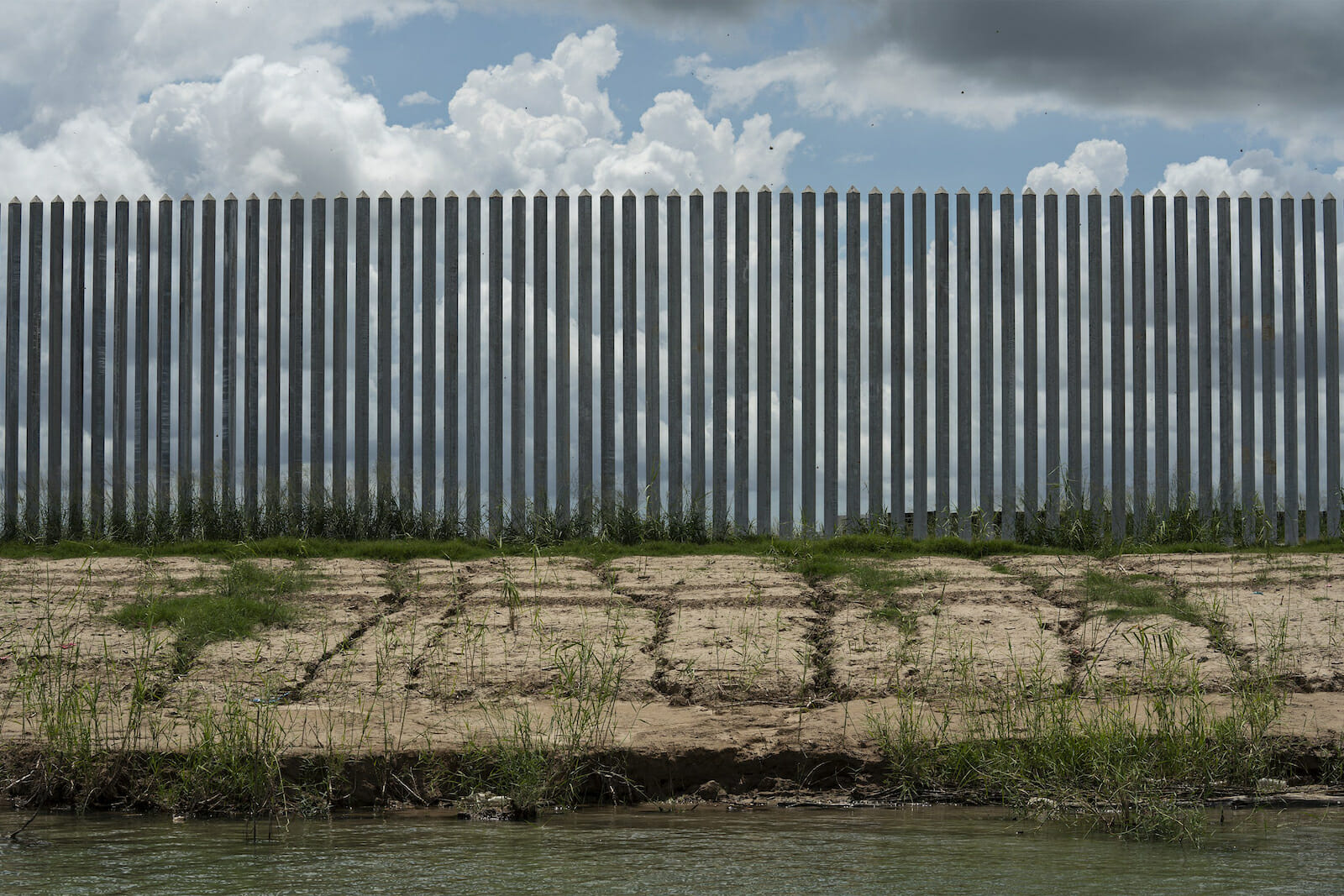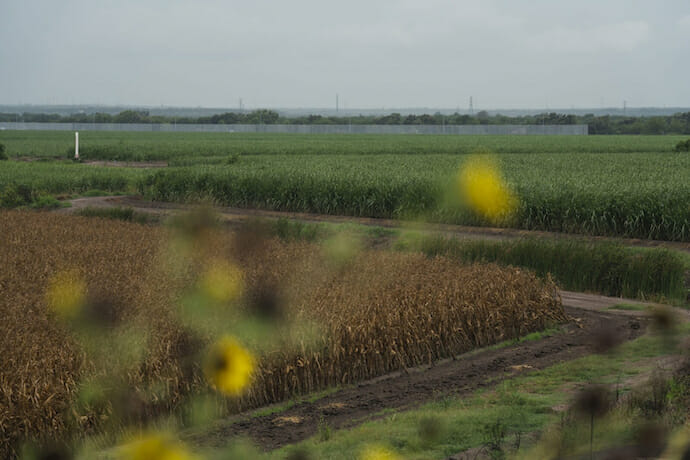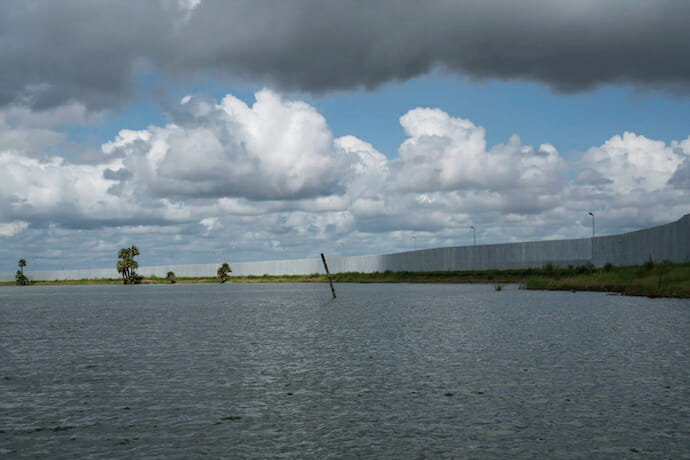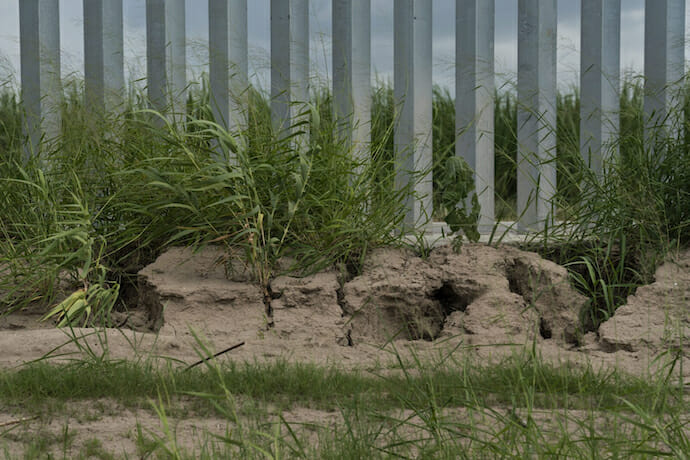
He Built a Privately Funded Border Wall. It’s Already at Risk of Falling Down if Not Fixed.
Tommy Fisher billed his new privately funded border wall as the future of deterrence, a quick-to-build steel fortress that spans 3 miles in one of the busiest Border Patrol sectors.
Unlike a generation of wall builders before him, he said he figured out how to build a structure directly on the banks of the Rio Grande, a risky but potentially game-changing step when it came to the nation’s border wall system.
Fisher has leveraged his self-described “Lamborghini” of walls to win more than $1.7 billion worth of federal contracts in Arizona.
But his showcase piece is showing signs of runoff erosion and, if it’s not fixed, could be in danger of falling into the Rio Grande, according to engineers and hydrologists who reviewed photos of the wall for ProPublica and The Texas Tribune. It never should have been built so close to the river, they say.
Just months after going up, they said, photos reveal a series of gashes and gullies at various points along the structure where rainwater runoff has scoured the sandy loam beneath the foundation.
“When the river rises, it will likely attack those areas where the foundation is exposed, further weakening support of the fence and potentially causing portions…to fall into the Rio Grande,” said Alex Mayer, a civil engineer professor at the University of Texas at El Paso who has done research in the Rio Grande basin.
Fisher dismissed the concerns. A company attorney, Mark Courtois, called the erosion “a normal part of new construction projects like this and does not in any way compromise the fence or associated roadway.” The company will seek to build drainage ditches to lessen the deterioration, he added. Neither Courtois nor Fisher responded to additional questions made through Courtois’ office.
The Mission private wall project, Fisher’s second following a similar undertaking outside El Paso, is a little known but crucial part of the effort to help President Donald Trump meet his campaign promise to build 450 miles of “big, beautiful wall” by the end of 2020. For the administration, Texas remains the biggest challenge. That’s because the Rio Grande has served as a natural divider, and, unlike other states, most land abutting it is privately owned.
Fisher’s New Mexico and South Texas private fence projects have gone up with financial and political help from We Build the Wall, an influential conservative nonprofit that counts former Trump political strategist Steve Bannon as a board member. The group says it has raised $25 million toward the private wall effort and claims to have agreements with landowners on 250 miles of riverfront property in Texas.
Fisher’s success and the $1.3 billion contract in Arizona he won in May — the largest border wall contract ever awarded — came despite repeated questions about his qualifications and work. Army Corps of Engineers officials have said the firm won because it submitted the lowest bid.
Last December, Rep. Bennie Thompson, D-Miss., called for the Pentagon’s inspector general to review Fisher’s first $400 million fence contract, awarded in December over concerns of “inappropriate influence.” The audit is ongoing.
Victor Manjarrez, associate director for the University of Texas at El Paso’s Center for Law and Human Behavior, said he would never have built along the river’s edge.
“That is nuts,” said Manjarrez, a former El Paso sector chief for the Border Patrol, who spent years working along the Rio Grande. “You’re going to get all the hydrology problems and not even from a flood, just normal ebb and flow…If I was the sector chief and built something like that, I’d be in so much trouble.”
Building Challenges

Located on the southernmost tip of Texas, the Rio Grande Valley’s unique terrain has challenged wall builders for nearly two decades. The topography of the Valley includes a wide floodplain that has forced the government to construct barriers inland, on top of a levee system. That has left swaths of farmland, cemeteries and even homes in a kind of no man’s land south of the fence, which has been built in fits and starts.
Though tamed by a series of irrigation and flood control dams, the Rio Grande floods periodically, and sometimes catastrophically. In 2010, Hurricane Alex caused widespread damage along the banks of the river, including at the National Butterfly Center, just upriver from Fisher’s fence.
“People don’t appreciate the power of the Rio Grande when it does indeed wake up,” said Jude Benavides, who specializes in floodplain mapping in the Lower Rio Grande Valley at the University of Texas Rio Grande Valley. “It changes the landscape.”
Fisher has said his wall — about a mile south of where the government is already building its version — will finally bring “border security to the border” through a design that erases the flooding and erosion concerns that had scuttled earlier plans and vastly speeds up construction time.
It would be the first wall system that wouldn’t cause flooding or deflect water, We Build the Wall founder Brian Kolfage claimed in a tweet. “The best engineers in the world designed this for floods, not government employees.”
Fisher’s system uses excavators to hang bollard sections, and without having to obtain myriad permits and approvals, he built it in just a matter of weeks, in stark contrast to government projects that take months or years to complete.

Fisher doesn’t have to meet even those scaled-down requirements.
Government builders have also been slowed by eminent domain battles with landowners reluctant to sell. Fisher said his riverside building plan is more attractive to those hoping to avoid a fence bisecting their land and leaving acres behind a fence.
How Fisher Started Building
Fisher’s strategy was years in the making. Soon after the 2016 election, he became a frequent guest on Fox News, where he caught the attention of Trump. Last year, The Washington Post reported that the president “latch(ed) on” to Fisher’s claims of speed and quality and “aggressively pushed” for the firm in conversations with top Homeland Security officials.
But Fisher’s border wall business got off to a rocky start, despite paying a lobbying firm tens of thousands of dollars to push for contracts. In 2017, the firm, founded in 1952 and best known for large highway projects, had its wall prototype rejected by the Department of Homeland Security. It later attempted to join an elite group of preapproved border wall bidders, but it was again turned down by the Army Corps of Engineers, which said it failed to meet its requirements or obtain the necessary regulatory approvals.
In response, Fisher sued the department and was added to the list of preapproved bidders thanks to White House pressure, administration officials told the Post last year.
Fisher was also aided by a close relationship with freshman U.S. Sen. Kevin Cramer, R-N.D., who advocated for the company with Trump and Trump’s son-in-law, Jared Kushner. Fisher and family members donated at least $24,000 during Cramer’s victorious 2018 bid, according to campaign finance records. Cramer’s spokesperson did not return emails for comment.
Fisher’s ambition was matched by his brashness, another quality that observers say drew him to the president. Last year, he compared traditional government wall building to a horse and carriage. “But I have a Lamborghini, and there’s gonna be this concrete road, and we can do two hundred miles an hour, not ten,” he told Texas Monthly.
As Cramer lobbied for the company, which included bringing Fisher to Trump’s 2018 State of the Union address, Fisher embarked on two private ventures alongside We Build the Wall, whose board members include immigration hardliners such as former Colorado congressman Tom Tancredo, former Milwaukee Sheriff David Clarke and former Kansas Secretary of State Kris Kobach.
The first was in a mountainous area of Sunland Park, New Mexico, just outside of El Paso, where a half-mile wall of fencing appeared seemingly overnight to the surprise of local residents around Memorial Day 2019.
Sunland Park officials temporarily halted the group’s fence project because it lacked proper building permits, prompting We Build The Wall to launch a campaign to flood town personnel with pushback.
“So Sunland Park officials support open borders, the sex slaves and illegal drugs coming into their communities?” Kolfage responded on Twitter, and he directed followers to “burn up the phone lines.”
Sunland Park Mayor Javier Perea said he received several death threats and thousands of messages, some telling him to watch his back and that opposition to the wall is equivalent to treason. “I will support legislation to that effect,” one email read. “I would attend the hangings.”
“If they had followed the rules from the very beginning, this wouldn’t have been so much chaos and controversy,” he told ProPublica and The Texas Tribune. “But that was not their intention, their intention was to bring attention to the issues and fundraising.” The city ultimately issued the permits and the wall is still standing.
Six months later, Fisher moved 800 miles east, and as his companies did in Sunland Park, he began building, this time along the sandy banks of the Rio Grande.
A Lawsuit Slows Building
The $42 million project, which included a $1.5 million contribution from We Build the Wall, sputtered at the start. As Fisher began clearing a path for the wall, his company was sued by the federal government and a neighboring wildlife refuge in December.
The National Butterfly Center and the International Boundary and Water Commission brought Fisher Sand & Gravel Co. and its subsidiaries to court to stop it from building the fence until it submitted a detailed engineering study to determine the fence’s impact on the flow of the Rio Grande and nearby properties.
The IBWC is a binational body that regulates building in the floodplain between the U.S. and Mexico because structures can worsen flooding and alter the course of the river, potentially violating international water treaties. Here, the international boundary is an imaginary line through the middle of the river.

The commission had dealt with Fisher in New Mexico, where it also raised concerns after his team built on federal property without permission. In turn, Kolfage, a decorated Iraq War veteran, responded with a social media campaign implying the IBWC and its commissioner, Jayne Harkins, a Trump appointee, were letting unauthorized immigrants into the country and undermining the president.
That pattern repeated in Texas. Kolfage took aim at the National Butterfly Center as well as Rev. Roy Snipes, the parish priest at La Lomita church, an iconic sanctuary built along the Rio Grande in 1899. Both are critics of the private wall effort and previously convinced lawmakers to exempt their properties from future government wall-building plans.
Kolfage tweeted that they were “promoting the trafficking of children,” and that the butterfly center was home to “rampant sex trade.”
The center’s executive director Marianna Treviño-Wright also received death threats. One irate Facebook user told her, “You need to all be in jail or hanged.”
It was “shocking” to be on the receiving end of such hate, said Treviño-Wright, who worries about the financial impact on the 100-acre wildlife center, which educates the public about biodiversity and relies on grants and donations.
In court, the IBWC complained to U.S. District Judge Randy Crane that instead of submitting the required comprehensive hydraulic models, Fisher and his team had turned in a six-page document with basic drawings that lacked necessary details.
Despite repeated requests for the additional information and assurances that construction would stop until the U.S. section of the IBWC could analyze the model and confer with its Mexican counterparts, Fisher Industries continued to dig trenches, remove vegetation and grade the banks, court testimony shows.
Fisher insisted that he was acting in good faith and that he had met with IBWC officials, including Harkins, before the project to show them what his builders planned to do. The agency, he testified, didn’t raise any red flags with the project and told him its jurisdiction was limited on private property.
Crane ruled in Fisher’s favor in January, saying that even though the engineering studies hadn’t been completed, government attorneys had failed to show that the project would violate the treaty with Mexico. He allowed Fisher to proceed with construction, but the lawsuit continued as the IBWC ran the hydraulic models. Two months later, with the nation’s attention fixated on the COVID-19 outbreak, Kolfage hailed the fence’s completion with a highly produced video.
.@WeBuildtheWall project 2: 3.5 miles spearheaded by @FisherSandG. The craftsmanship by fisher is best in the world. And this wall is the first to ever be built on the rio grande border.@realDonaldTrump @DonaldJTrumpJr @charliekirk11 @RyanAFournier @LouDobbs @TeamCavuto pic.twitter.com/WXvSe9GhZK
— Brian Kolfage (@BrianKolfage) March 3, 2020
In March, the IBWC’s model determined the fence violated the treaty by deflecting too much water at one point along its length. But overall, it found the wall’s impacts to be minor and recommended small design changes, such as installing a gate.
Lawrence Dunbar, an environmental and civil engineer who reviewed the report on behalf of ProPublica and The Texas Tribune, said the model was off, in part because it used flawed bollard width measurements that would show less blockage. The IBWC also needed to start the model farther upstream from the fence for it to work properly, he said.
“I would have expected that the fence would increase the water level (during a flooding event), the only question was by how much,” said Dunbar, who has 30 years of experience in flood and drainage matters and is a former lead hydrologist for the Army Corps of Engineers in the development of various floodplains for FEMA.
“You are putting in an obstruction, a barrier, in the middle of the floodplain of a major river that has a levee back away from it,” said Dunbar, who has served as an expert witness on a number of state and federal lawsuits, including before the U.S. Supreme Court. “It’s important they get it right, and they clearly did not get it right.”
Sally Spener, a spokeswoman for the IBWC, said the commission couldn’t comment on specifics of the model because of the pending lawsuit against Fisher, but she said the commission’s engineers have “top-notch qualifications and experience.”
Critics say the commission’s decision reflects relaxed oversight at the agency, which in recent years has allowed more construction-friendly hydrology models in part because of political pressure.
“They still know the U.S. cannot guarantee that the fence will not adversely affect Mexico and will not affect the boundary in a flood,” said Stephen Mumm, a political science professor at Colorado State University, who has spent decades studying U.S.-Mexico water diplomacy.
But, he added, each section has to represent its respective governments and be responsive to their presidents.
For the first time in February, IBWC Commissioner Harkins donated a total of $500 to the Trump campaign and a Republican political action committee, even as her agency was suing Fisher for failing to prove its fence would not violate the treaty she oversees. None of her three predecessors made similar contributions during their tenure, according to federal campaign contribution records. Through a spokeswoman, Harkins said, she “simply responded to a routine solicitation for a political contribution.”
While Mexico has opposed border wall projects, it has done so quietly. Officials refused to comment for this story, referring all questions to the U.S. section of the commission. Spener said their Mexican counterparts are still reviewing the updated hydraulic model.
But they are concerned about potential obstruction that could raise water elevation as a result, she said, and that the fence could be knocked down during a flood, causing downstream impacts.
Why Border Walls Aren’t Built by the River
There’s a reason neither the government nor the private sector has built large structures so close to the river. Given the dynamics of the water, the type of terrain and the distance, it wasn’t a matter of whether there would be issues, experts said, it was a matter of how soon.
ProPublica and The Texas Tribune consulted six hydrologists and engineers, with expertise in wall construction, building near waterways or familiarity with the Rio Grande. They analyzed a combination of the six-page analysis from Fisher Industries; a 24-page hydraulic analysis by the IBWC from March; a series of photos of the fence and project details taken from court testimony.
Unlike the bollard fences that the government builds 6 to 7 feet into the ground, Fisher’s wall has roughly a 2 1/2-foot foundation that stretches 8 feet wide. During court testimony, Greg Gentsch, the project’s engineer, downplayed the impact of wind on the fence’s shallow foundation and said he was confident that the footing design was appropriate for the area.
“To me, that was the biggest mistake they made,” said Joseph Jarvis, an engineer who worked on border wall segments 12 years ago. “While they focused on the velocity of the water that would go through the bollards, the bigger problem is the water that runs parallel (to the fence), that’s the one that’s going to erode the dirt that’s supporting the foundation.”

Amy Patrick, a Houston forensic structural and civil engineer and court-recognized expert on wall construction, said she worries about its stability long-term. “They are relying on a very shallow foundation to prevent overturning and then not taking care to ensure the bank on the Rio Grande side of the fence does not erode,” said Patrick, who has questioned the engineering viability of border walls generally along the southern border.
Fisher’s team stripped the bank of its vegetation. They said it had been reseeded but the photographs still show bald spots. Native vegetation is key, said Adriana E. Martinez, a Southern Illinois University Edwardsville professor and geomorphologist who has studied the impact of the barriers on her hometown of Eagle Pass, Texas. It helps slow erosion and minimize the amount of sediment going into the river, which can affect water quality. The Rio Grande supplies drinking water for more than 6 million people.
Solutions to the fence’s erosion range from filling the areas that are eroded and thoroughly revegetating with native species to installing piers beneath the foundation, some more costly than others. It will also require constant monitoring and maintenance, the experts said, as debris can clog the fence during heavy storms potentially worsening flooding.
Spener, who confirmed the erosion, said the IBWC has advised Fisher that the company needs to monitor the slope and repair any issues “in a timely manner.”
But it’s unclear what Fisher’s maintenance plan is. Neither the IBWC nor Javier Peña, the attorney representing the National Butterfly Center, has received a copy from Fisher since they requested it in April.
Courtois, the company attorney, did not comment on the maintenance issue, but he said the fence and roadway have performed as intended and are structurally sound. He said Fisher had personally inspected the site last week and attributed the erosion to light surface sand and the parts where “vegetation has not yet fully taken hold.”
Spener said the commission’s enforcement authority in terms of ordering fixes or changes to a completed structure would be decided in the ongoing lawsuit.
U.S. Rep. Joaquín Castro, D-Texas, called the privately funded wall an illegal vanity project that jeopardizes the property and safety of Texas landowners. He urged the IBWC and courts to take the erosion seriously.
“It’s clear that no degree of ‘adjustments’ to the wall will work,” said Castro, vice-chair of the House Foreign Affairs Committee. “This unnecessary ‘wall’ must be taken down.”
More Border Wall to Build
The New Mexico and South Texas projects are likely only the beginning for Fisher and We Build the Wall. They’ve both touted agreements with landowners in Texas for hundreds of miles of riverfront property, where the entities could conceivably build more walls like the one in Mission. Kolfage declined to specify locations.
They’ve said they hope to sell or donate the walls to the U.S. government. So far U.S. Customs and Border Protection has not agreed to take control of the Mission fence, but it has said it is not concerned about the private wall interfering with its own efforts in the region, which include building a parallel wall on about 13 miles of newly refurbished levee — about a mile above the Fisher structure — as part of a larger $300 million project.
And following construction of the Mission fence, the Department of Homeland Security in May announced it was open to allowing private firms to pitch border fence projects. Kolfage called the change a direct result of the private wall projects, which “prov(ed) the power of private enterprise.”
Out of 30 possible locations identified by the government for potential private wall projects, 23 are in Texas.
Another federal court hearing is scheduled for next week, where Peña, the attorney for butterfly center, said he will urge the judge to order an immediate inspection.
Also unresolved is the IBCW’s push for a fix to the deflection problem, where the fence can obstruct the path of the river during a flood event, in violation of the international treaty. Spener said they’ve asked Fisher for a plan detailing how they propose to address the issue.
At least for now, Fisher has packed his equipment and moved out west again, where he is erecting a 30-foot fence along the southern Arizona border for the federal government.
“They built the wall and left,” Peña said. “They got their donations, their government contract and they left us.”
This article was originally published on The Texas Tribune. Read the original article.





